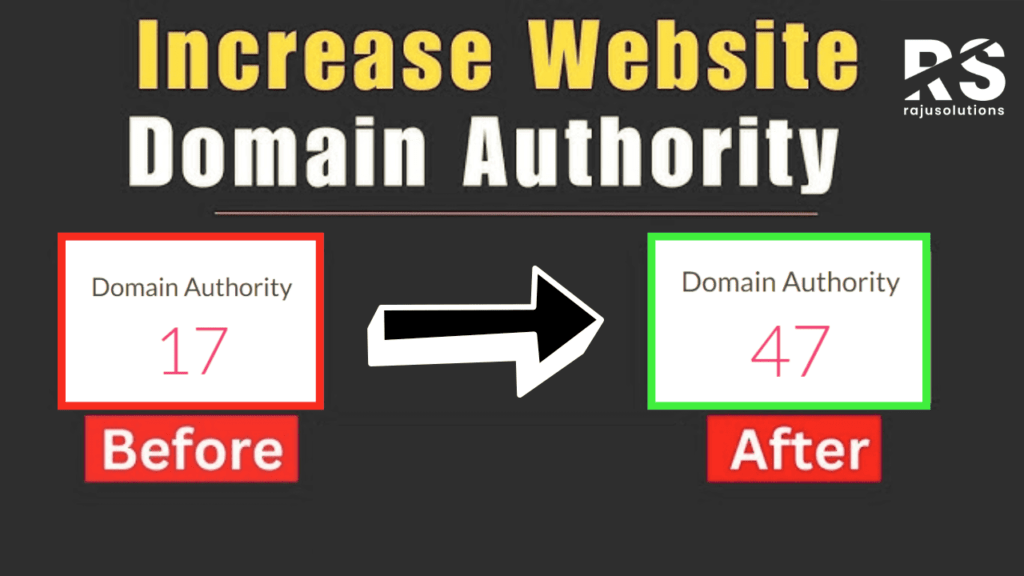
Domain Authority (DA) is one of the most discussed SEO metrics today. Developed by Moz, it predicts how likely a website is to rank on search engine result pages (SERPs). The DA score ranges from 1 to 100, with higher scores indicating a stronger ability to rank.
Although Google doesn’t use DA as an official ranking factor, it’s a great way to measure your website’s overall SEO strength. A higher DA generally means you have:
- Quality backlinks from trusted sites
- Strong technical SEO
- Valuable content that attracts readers
- A good reputation across the web
In this guide, I’ll explain what affects your Domain Authority and how you can improve it step by step.
🔹 What Affects Domain Authority?
Your DA score is not static — it changes based on multiple SEO factors:
- Backlinks: The number and quality of links pointing to your site.
- Content Quality: How valuable and original your content is.
- User Experience (UX): Mobile-friendliness, page speed, and navigation.
- Technical SEO: Crawlability, indexability, XML sitemaps, schema, etc.
- Internal Linking: How well your pages connect with each other.
If you focus on these factors, your DA will naturally improve over time.
✅ Proven Ways to Increase Domain Authority
1. Build High-Quality Backlinks
Backlinks are still the backbone of SEO. When authoritative websites link back to your site, it tells search engines that your content is trustworthy.
How to build strong backlinks:
- Guest posting on high-DA blogs
- Profile backlinks on relevant platforms
- Sharing content on publishing sites (Medium, Issuu, Scribd, Behance, etc.)
- Content outreach and collaborations
Why it works: High-quality backlinks not only improve your DA but also bring in referral traffic and improve your keyword rankings.
2. Write High-Quality Content
Without content, backlinks won’t exist. Search engines reward websites that publish helpful, original, and engaging articles.
- Focus on solving your audience’s problems.
- Keep your articles easy to read with headings, bullet points, and visuals.
- Update your content regularly to stay relevant.
👉 Example: Instead of writing a generic blog post like “Best Phones in 2025,” write a detailed comparison guide with pros and cons, so readers find it more valuable.
3. Remove Toxic Backlinks
Not all backlinks are good. Some links from spammy or irrelevant websites can hurt your DA.
- Use tools like Moz, Ahrefs, or SEMrush to identify harmful backlinks.
- Disavow bad links using Google Search Console.
👉 Think of it like cleaning your house — removing toxic backlinks improves your site’s reputation and helps maintain a strong DA.
4. Improve User Experience (UX)
Google considers user signals like bounce rate, time on site, and mobile usability. If your visitors leave quickly, it can impact your rankings.
- Make sure your website loads in under 3 seconds.
- Ensure mobile responsiveness.
- Use a clean, easy-to-navigate design.
Good UX keeps visitors engaged, reduces bounce rate, and strengthens your overall authority.
5. Strengthen Technical SEO
Technical SEO is like the backbone of your website. Without it, even the best content and backlinks won’t help.
Checklist for strong technical SEO:
- Submit a proper XML Sitemap.
- Optimize your robots.txt file.
- Ensure your site is HTTPS secure.
- Use schema markup for rich snippets.
- Fix crawl errors in Google Search Console.
- Improve website speed with caching and CDN.
👉 A technically strong website ensures that Google can crawl and index your pages correctly.
6. Use Internal Linking
Internal links are often ignored, but they are powerful for SEO.
- Link new articles to old articles and vice versa.
- Use keyword-rich anchor text naturally.
- Spread link equity to important landing pages.
Internal linking improves navigation, distributes DA across your site, and keeps users engaged longer.
📊 High-DA Backlink Opportunities
Here’s a curated list of websites where you can create profile backlinks or publish content. These platforms can significantly strengthen your link profile:
| Website | DA | Spam Score |
| IntenseDebate | 86 | 1% |
| GitConnected | 56 | 1% |
| SpaceHey | 49 | 1% |
| Motion Gallery | 59 | 1% |
| DeviantArt | 90 | 1% |
| Project Noah | 60 | 1% |
| Kuula | 49 | 1% |
| Graphis | 65 | 1% |
| SecondStreet | 50 | 1% |
| Cannabis.net | 55 | 1% |
| Best4Discounts | 86 | 1% |
| Trinidad Weddings | 56 | 1% |
| Annunci Gratuit Italia | 49 | 1% |
| Snipe Social | 45 | 1% |
| Pozible | 74 | 1% |
| Linktr.ee | 94 | 1% |
| Issuu | 94 | 1% |
| Scribd | 94 | 1% |
| 4Shared | 94 | 1% |
| Behance | 93 | 1% |
| Giphy | 92 | 1% |
| HeyLink | 90 | 1% |
| SpeakerDeck | 85 | 1% |
| Coub | 87 | 9% |
| WalkScore | 76 | 1% |
| Temptalia | 75 | 1% |
| Pantip | 78 | 1% |
| s.id | 81 | 1% |
| Charity Water | 80 | 1% |
| NiftyGateway | 63 | 1% |
| Division Midway | 44 | 1% |
| LifeInSys | 60 | 1% |
| Boston Calendar | 57 | 1% |
| SunCommunity Jobs | 54 | 1% |
🙋 Frequently Asked Questions (FAQs)
Q1: How long does it take to increase Domain Authority?
It usually takes 3–6 months of consistent effort (backlinks, content, technical SEO) to see improvements.
Q2: Is DA a Google ranking factor?
No. DA is developed by Moz. But improving DA naturally helps with better Google rankings.
Q3: What is a good DA score?
- New websites: DA 10–20 is normal.
- Growing websites: DA 30–50 is strong.
- Authority websites: DA 60+ is excellent.
Q4: Can toxic backlinks reduce DA?
Yes. Spammy links can lower your DA and even lead to ranking drops. Always monitor and remove them.
Q5: Do internal links help increase DA?
Yes. Internal links distribute authority across your site and help Google crawl your pages effectively.
🎯 Final Thoughts
Improving Domain Authority is a long-term SEO strategy, not an overnight task. By focusing on quality backlinks, original content, technical SEO, UX improvements, and internal linking, you can steadily increase your DA and strengthen your website’s position in search engines.
Keep in mind: DA is just a metric. What really matters is better rankings, organic traffic, and conversions. If you consistently follow these strategies, your DA will grow — and so will your business.

